Brian Gaudet
Deep Reinforcement Learning for Weapons to Targets Assignment in a Hypersonic strike
Oct 27, 2023Abstract:We use deep reinforcement learning (RL) to optimize a weapons to target assignment (WTA) policy for multi-vehicle hypersonic strike against multiple targets. The objective is to maximize the total value of destroyed targets in each episode. Each randomly generated episode varies the number and initial conditions of the hypersonic strike weapons (HSW) and targets, the value distribution of the targets, and the probability of a HSW being intercepted. We compare the performance of this WTA policy to that of a benchmark WTA policy derived using non-linear integer programming (NLIP), and find that the RL WTA policy gives near optimal performance with a 1000X speedup in computation time, allowing real time operation that facilitates autonomous decision making in the mission end game.
Line of Sight Curvature for Missile Guidance using Reinforcement Meta-Learning
Apr 29, 2022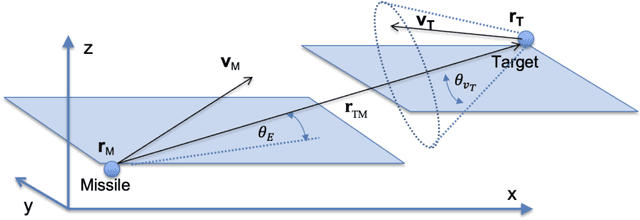
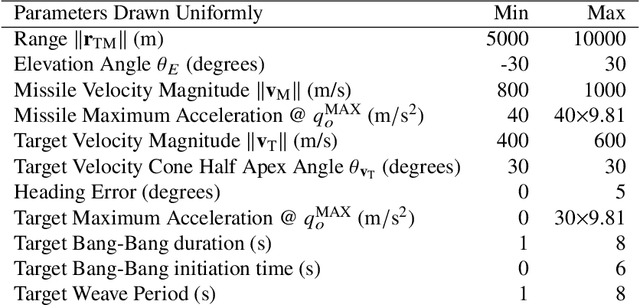
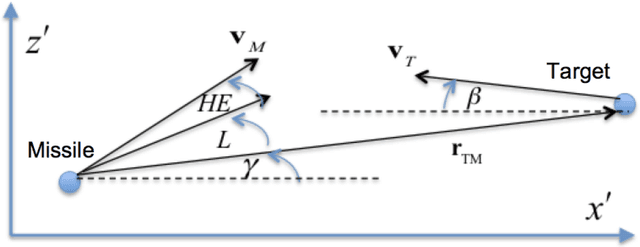
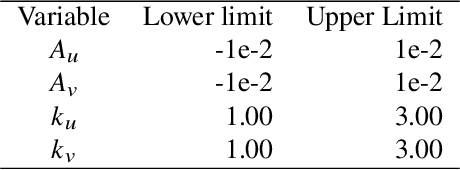
Abstract:We use reinforcement meta learning to optimize a line of sight curvature policy that increases the effectiveness of a guidance system against maneuvering targets. The policy is implemented as a recurrent neural network that maps navigation system outputs to a Euler 321 attitude representation. The attitude representation is then used to construct a direction cosine matrix that biases the observed line of sight vector. The line of sight rotation rate derived from the biased line of sight is then mapped to a commanded acceleration by the guidance system. By varying the bias as a function of navigation system outputs, the policy enhances accuracy against highly maneuvering targets. Importantly, our method does not require an estimate of target acceleration. In our experiments, we demonstrate that when our method is combined with proportional navigation, the system significantly outperforms augmented proportional navigation with perfect knowledge of target acceleration, achieving improved accuracy with less control effort against a wide range of target maneuvers.
Integrated Guidance and Control for Lunar Landing using a Stabilized Seeker
Dec 16, 2021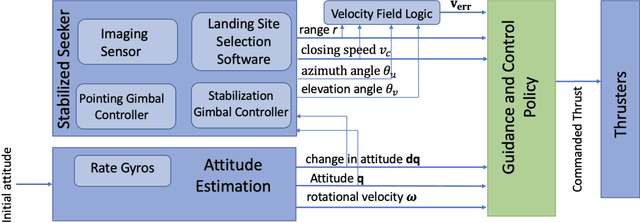
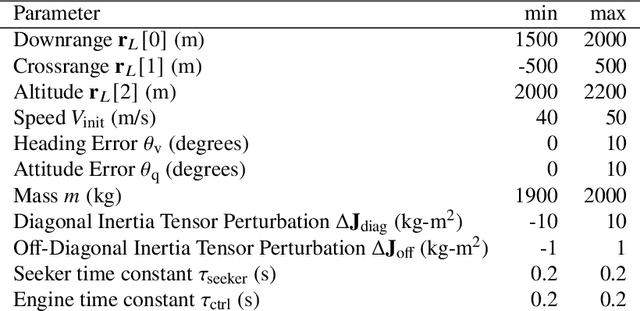
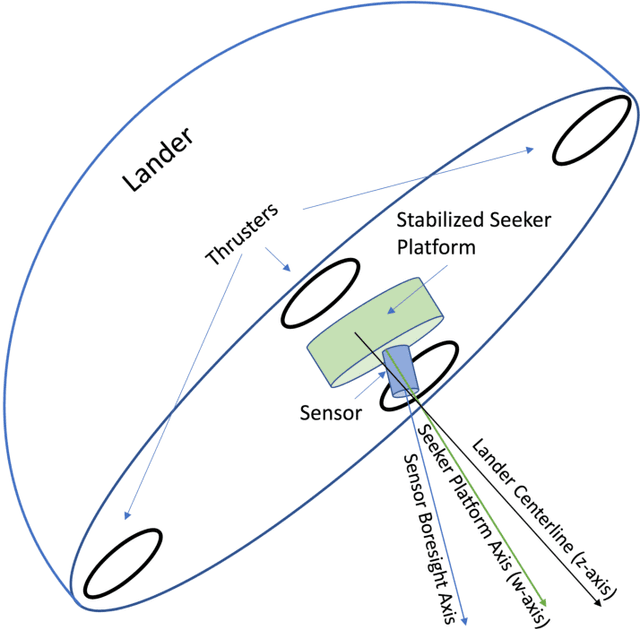
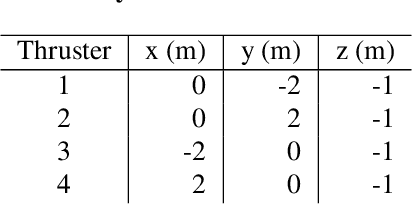
Abstract:We develop an integrated guidance and control system that in conjunction with a stabilized seeker and landing site detection software can achieve precise and safe planetary landing. The seeker tracks the designated landing site by adjusting seeker elevation and azimuth angles to center the designated landing site in the sensor field of view. The seeker angles, closing speed, and range to the designated landing site are used to formulate a velocity field that is used by the guidance and control system to achieve a safe landing at the designated landing site. The guidance and control system maps this velocity field, attitude, and rotational velocity directly to a commanded thrust vector for the lander's four engines. The guidance and control system is implemented as a policy optimized using reinforcement meta learning. We demonstrate that the guidance and control system is compatible with multiple diverts during the powered descent phase, and is robust to seeker lag, actuator lag and degradation, and center of mass variation induced by fuel consumption. We outline several concepts of operations, including an approach using a preplaced landing beacon.
Terminal Adaptive Guidance for Autonomous Hypersonic Strike Weapons via Reinforcement Learning
Oct 16, 2021
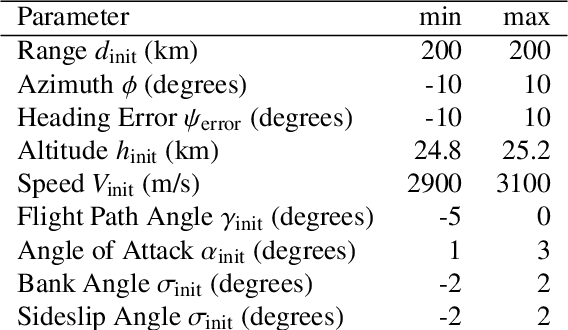
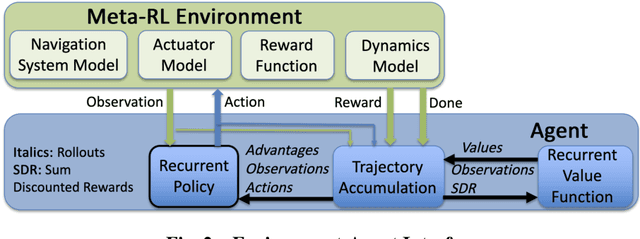
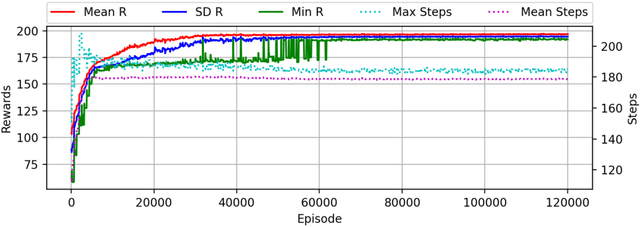
Abstract:An adaptive guidance system suitable for the terminal phase trajectory of a hypersonic strike weapon is optimized using reinforcement meta learning. The guidance system maps observations directly to commanded bank angle, angle of attack, and sideslip angle rates. Importantly, the observations are directly measurable from radar seeker outputs with minimal processing. The optimization framework implements a shaping reward that minimizes the line of sight rotation rate, with a terminal reward given if the agent satisfies path constraints and meets terminal accuracy and speed criteria. We show that the guidance system can adapt to off-nominal flight conditions including perturbation of aerodynamic coefficient parameters, actuator failure scenarios, sensor scale factor errors, and actuator lag, while satisfying heating rate, dynamic pressure, and load path constraints, as well as a minimum impact speed constraint. We demonstrate precision strike capability against a maneuvering ground target and the ability to divert to a new target, the latter being important to maximize strike effectiveness for a group of hypersonic strike weapons. Moreover, we demonstrate a threat evasion strategy against interceptors with limited midcourse correction capability, where the hypersonic strike weapon implements multiple diverts to alternate targets, with the last divert to the actual target. Finally, we include preliminary results for an integrated guidance and control system in a six degrees-of-freedom environment.
Integrated and Adaptive Guidance and Control for Endoatmospheric Missiles via Reinforcement Learning
Sep 08, 2021

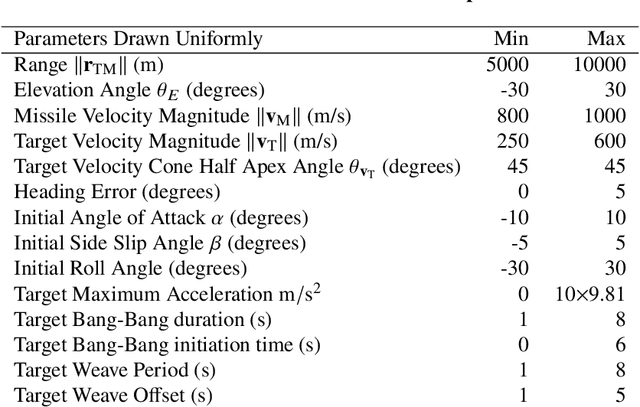

Abstract:We apply the meta reinforcement learning framework to optimize an integrated and adaptive guidance and flight control system for an air-to-air missile, implementing the system as a deep neural network (the policy). The policy maps observations directly to commanded rates of change for the missile's control surface deflections, with the observations derived with minimal processing from the computationally stabilized line of sight unit vector measured by a strap down seeker, estimated rotational velocity from rate gyros, and control surface deflection angles. The system induces intercept trajectories against a maneuvering target that satisfy control constraints on fin deflection angles, and path constraints on look angle and load. We test the optimized system in a six degrees-of-freedom simulator that includes a non-linear radome model and a strapdown seeker model. Through extensive simulation, we demonstrate that the system can adapt to a large flight envelope and off nominal flight conditions that include perturbation of aerodynamic coefficient parameters and center of pressure locations. Moreover, we find that the system is robust to the parasitic attitude loop induced by radome refraction, imperfect seeker stabilization, and sensor scale factor errors. Finally, we compare our system's performance to two benchmarks: a proportional navigation guidance system benchmark in a simplified 3-DOF environment, which we take as an upper bound on performance attainable with separate guidance and flight control systems, and a longitudinal model of proportional navigation coupled with a three loop autopilot. We find that our system moderately outperforms the former, and outperforms the latter by a large margin.
Adaptive Approach Phase Guidance for a Hypersonic Glider via Reinforcement Meta Learning
Jul 30, 2021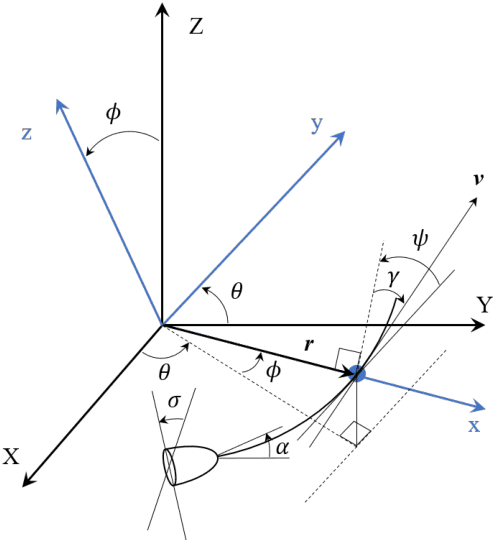
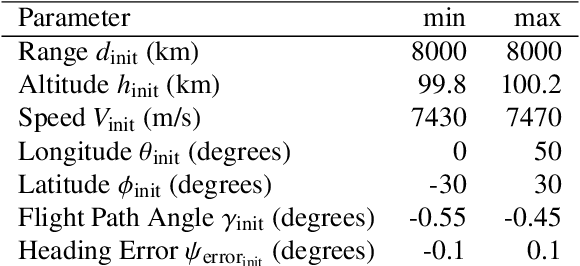
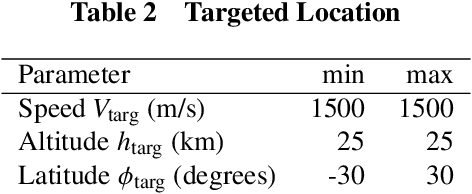
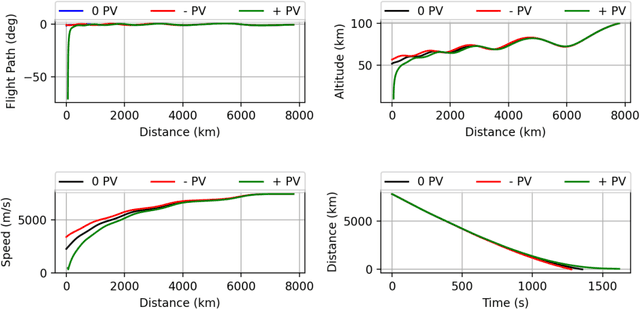
Abstract:We use Reinforcement Meta Learning to optimize an adaptive guidance system suitable for the approach phase of a gliding hypersonic vehicle. Adaptability is achieved by optimizing over a range of off-nominal flight conditions including perturbation of aerodynamic coefficient parameters, actuator failure scenarios, and sensor noise. The system maps observations directly to commanded bank angle and angle of attack rates. These observations include a velocity field tracking error formulated using parallel navigation, but adapted to work over long trajectories where the Earth's curvature must be taken into account. Minimizing the tracking error keeps the curved space line of sight to the target location aligned with the vehicle's velocity vector. The optimized guidance system will then induce trajectories that bring the vehicle to the target location with a high degree of accuracy at the designated terminal speed, while satisfying heating rate, load, and dynamic pressure constraints. We demonstrate the adaptability of the guidance system by testing over flight conditions that were not experienced during optimization. The guidance system's performance is then compared to that of a linear quadratic regulator tracking an optimal trajectory.
Reinforcement Meta-Learning for Interception of Maneuvering Exoatmospheric Targets with Parasitic Attitude Loop
Apr 18, 2020



Abstract:We use Reinforcement Meta-Learning to optimize an adaptive integrated guidance, navigation, and control system suitable for exoatmospheric interception of a maneuvering target. The system maps observations consisting of strapdown seeker angles and rate gyro measurements directly to thruster on-off commands. Using a high fidelity six degree-of-freedom simulator, we demonstrate that the optimized policy can adapt to parasitic effects including seeker angle measurement lag, thruster control lag, the parasitic attitude loop resulting from scale factor errors and Gaussian noise on angle and rotational velocity measurements, and a time varying center of mass caused by fuel consumption and slosh. Importantly, the optimized policy gives good performance over a wide range of challenging target maneuvers. Unlike previous work that enhances range observability by inducing line of sight oscillations, our system is optimized to use only measurements available from the seeker and rate gyros. Through extensive Monte Carlo simulation of randomized exoatmospheric interception scenarios, we demonstrate that the optimized policy gives performance close to that of augmented proportional navigation with perfect knowledge of the full engagement state. The optimized system is computationally efficient and requires minimal memory, and should be compatible with today's flight processors.
Six Degree-of-Freedom Hovering using LIDAR Altimetry via Reinforcement Meta-Learning
Nov 16, 2019



Abstract:We optimize a six degrees of freedom hovering policy using reinforcement meta-learning. The policy maps flash LIDAR measurements directly to on/off spacecraft body-frame thrust commands, allowing hovering at a fixed position and attitude in the asteroid body-fixed reference frame. Importantly, the policy does not require position and velocity estimates, and can operate in environments with unknown dynamics, and without an asteroid shape model or navigation aids. Indeed, during optimization the agent is confronted with a new randomly generated asteroid for each episode, insuring that it does not learn an asteroid's shape, texture, or environmental dynamics. This allows the deployed policy to generalize well to novel asteroid characteristics, which we demonstrate in our experiments. The hovering controller has the potential to simplify mission planning by allowing asteroid body-fixed hovering immediately upon the spacecraft's arrival to an asteroid. This in turn simplifies shape model generation and allows resource mapping via remote sensing immediately upon arrival at the target asteroid.
Seeker based Adaptive Guidance via Reinforcement Meta-Learning Applied to Asteroid Close Proximity Operations
Jul 13, 2019



Abstract:Current practice for asteroid close proximity maneuvers requires extremely accurate characterization of the environmental dynamics and precise spacecraft positioning prior to the maneuver. This creates a delay of several months between the spacecraft's arrival and the ability to safely complete close proximity maneuvers. In this work we develop an adaptive integrated guidance, navigation, and control system that can complete these maneuvers in environments with unknown dynamics, with initial conditions spanning a large deployment region, and without a shape model of the asteroid. The system is implemented as a policy optimized using reinforcement meta-learning. The spacecraft is equipped with an optical seeker that locks to either a terrain feature, back-scattered light from a targeting laser, or an active beacon, and the policy maps observations consisting of seeker angles and LIDAR range readings directly to engine thrust commands. The policy implements a recurrent network layer that allows the deployed policy to adapt real time to both environmental forces acting on the agent and internal disturbances such as actuator failure and center of mass variation. We validate the guidance system through simulated landing maneuvers in a six degrees-of-freedom simulator. The simulator randomizes the asteroid's characteristics such as solar radiation pressure, density, spin rate, and nutation angle, requiring the guidance and control system to adapt to the environment. We also demonstrate robustness to actuator failure, sensor bias, and changes in the spacecraft's center of mass and inertia tensor. Finally, we suggest a concept of operations for asteroid close proximity maneuvers that is compatible with the guidance system.
Adaptive Guidance with Reinforcement Meta-Learning
Jan 12, 2019



Abstract:This paper proposes a novel adaptive guidance system developed using reinforcement meta-learning with a recurrent policy and value function approximator. The use of recurrent network layers allows the deployed policy to adapt real time to environmental forces acting on the agent. We compare the performance of the DR/DV guidance law, an RL agent with a non-recurrent policy, and an RL agent with a recurrent policy in four difficult tasks with unknown but highly variable dynamics. These tasks include a safe Mars landing with random engine failure and a landing on an asteroid with unknown environmental dynamics. We also demonstrate the ability of a recurrent policy to navigate using only Doppler radar altimeter returns, thus integrating guidance and navigation.
 Add to Chrome
Add to Chrome Add to Firefox
Add to Firefox Add to Edge
Add to Edge